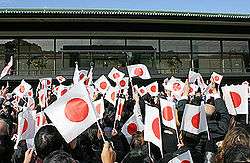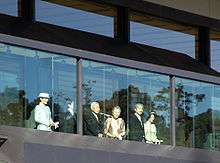The Emperor's Birthday
| The Emperor's Birthday | |
|---|---|
 Emperor Akihito prepares to greet the flag-waving crowd at the Imperial Palace on his birthday in 2004. | |
| Official name | Tennō tanjōbi (天皇誕生日) |
| Also called | Tenchōsetsu (天長節) |
| Observed by | Japan |
| Type | National, Public |
| Significance | Marks the birth date of the Emperor of Japan |
| Celebrations | Public ceremony at the Imperial Palace, royal greetings |
| Date | 23 December |

The Emperor's Birthday (天皇誕生日 Tennō tanjōbi) is a national holiday in the Japanese calendar celebrated on the birthday of the reigning Emperor, which is currently 23 December, as Emperor Akihito was born on that day in 1933.[1][2] Akihito is due to retire on 30 April 2019,[3] meaning that the holiday will not be observed in 2019, and its next celebration will be on the birthday of Crown Prince Naruhito (23 February 2020).
During the reign of Emperor Hirohito (Shōwa period, 1926–1989), the Emperor's birthday was observed on 29 April.[4] That date remained a public holiday, posthumously renamed Greenery Day in 1989 and Shōwa Day in 2007.[5]
Prior to World War II, it was called Tenchōsetsu (天長節), "Tenchō Festival". Tenchōsetsu paralleled Chikyūsetsu (地久節), "Chikyū Festival", which referred to the Empress consort's birthday. The two names originate from the Chinese idiom 天長地久, borrowed from Lao Tzu's Tao Te Ching during the reign of Emperor Kōnin, meaning "The sky and the earth, the universe is eternal", and expressed a hope for the eternal longevity of the reigning Emperor. After the war, the new government renamed it to Tennō tanjōbi, in less formal language with a more literal meaning in 1948, when it was established as a holiday by law. Under the law, the National Diet must convene and change the holiday date before the reigning Emperor's birthday becomes a public holiday.[6] Thus, there exists a small chance that the former Emperor's birthday may come before the change can be made.
On the Emperor's birthday, a public ceremony takes place at the Imperial Palace, where the gates of the palace are opened to public traffic (the Imperial Palace is usually off limits to the public). The Emperor, accompanied by the Empress, and several other members of the imperial family appear on a palace balcony to acknowledge the birthday congratulations of crowds of festive well-wishers waving tiny Japanese flags. Only on this occasion and on 2 January may the general public enter the inner grounds of the Imperial Palace.[6]
When the Emperor ceases his greeting, the crowd starts waving the flags again and the Imperial Family waves back.[7]
References
- ↑ "Japanese Holidays". japan-guide.com. Retrieved 23 December 2009.
- ↑ "Akihito". Britannica Online Encyclopedia. Retrieved 23 December 2009.
- ↑ McCurry, Justin (1 December 2017). "Akihito to become first Japanese emperor to abdicate in 200 years". The Guardian. Retrieved 21 December 2017.
- ↑ "Emperor Hirohito". Spartacus Educational. Retrieved 23 December 2009.
- ↑ "Golden Week". japan-guide.com. Retrieved 23 December 2009.
- 1 2 "Tenno No Tanjobi celebrates the Emperor's birthday in Japan". TokyoTopia Or Tokyo Made Simple. Retrieved 23 December 2009.
- ↑ "Traditional Annual Events". Japan National Tourism Organization. Retrieved 23 December 2009.